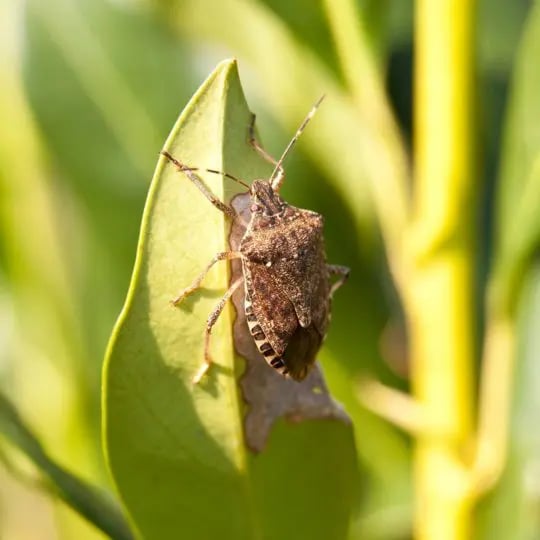
Scientific Name: Pentatomidae
Lifespan: 10 days to 9 months depending on species.
Problem: Emit foul odor when crushed or killed.
Stink bugs are outdoor insects that sometimes find themselves indoors in search of food and shelter. Stink bugs do not bit and rarely cause any phobic reactions, but they do emit a terrible smell – especially when crushed. The smell is what makes these pests a nuisance, and the reason that many families seek stink bug control services.
The Stink Bug Life Cycle
- Eggs – The eggs of the brown marmorated stink bug are white or light green, usually laid on the undersides of plant leaves in clusters of 20-30. A single female may lay up to 400 eggs in her lifetime.
- Juveniles – Juvenile stink bugs remain close to the egg cluster until they have molted twice, at which point they begin to disperse.
- Mature Bugs – Stink bugs usually reach maturity and begin to reproduce in fall. A full-grown stink bug is 1.7 millimeters long and distinctively shield-shaped. Some have a “striped” pattern on its antennae and the outer edge of its abdomen. Others are all green.
- Lifespan – Stink bugs are notoriously affected by the environment, so many do not live longer than a few weeks. However, there are some stink bugs that can live for 9 months.
Stink Bug Habitats and Habits
Stink bugs hide and hibernate under leaves, bark, or within house siding during winter. During the summer they can be found on the undersides of leaves, and are particularly slow in the mornings when the temperature is cooler. Stink bugs tend to only come indoors by accident. Their smell is so strong though, that only a single bug can affect the smell of your entire house.
Stink bugs enjoy legumes more than any other type of plant. They are considered crop pests but can make comfortable homes for themselves within residential gardens in summer and in houses during the winter.
How to Recognize and Get Rid of Stink Bug Infestations
If you are a gardener with fruits or vegetables growing in your garden, you can watch for clusters of light colored, barrel-shaped eggs on the undersides of leaves and punctured fruits that have developed a slight resemblance to a cat’s face (stink bugs are sometimes referred to as “cat-facing bugs” for this reason).
Usually the only way to prevent stink bugs from entering the home is to remove them outside, and to use traditional pest control barriers and exclusion to keep them out of your house. If you find a stink bug in your home and you want to get rid of stink bugs while avoiding their stink, a vacuum can be used to gather them up and dispose of them. They can also be picked by hand on cool mornings when they are slower to react with their trademark defensive odor. Never crush a stinkbug, and try to prevent grabbing at it and crushing it accidentally.
How to Get Rid of Stinkbug Smell
If your home already has the smell of stinkbugs, it can be tough to remove. It’s recommended that you use tomato juice on yourself if you have stinkbug smell on your hands, and try borax or lemon scented cleaner on any area that has the stinkbug smell.
Need Help with Stink Bug Prevention | PA, NJ & DE Stink Bug Control?
Call today at and let's talk about how we can help you with Stink Bug Prevention | PA, NJ & DE Stink Bug Control and other Pest Library.